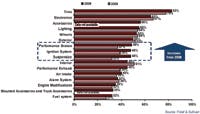Finding the right source to purchase your auto parts means doing your homework.
Successful independent service providers (a.k.a. retailers, jobbers, and parts resellers) offer their customers knowledgeable technicians, quality products, and superior service. But one of the major challenges is buying products at a price where a comfortable profit margin can be made.
When it comes to sourcing inventory, there are three places where ISPs look to buy: from a local wholesale distributor, through a program distribution channel, or directly from the manufacturer. Deciding on the best way for an ISP to purchase parts is not black and white. The large gray area depends on many factors: the risk threshold, location, and history of the business.
"Today's business is a lot about mixing and matching what fits your business needs," says Van Woodell, owner of Weathers Auto Supply in Petersburg, Virginia. "Most independents will go through a program distribution for the majority of their replacement parts or a WD like mine for specialty parts. The ones who do buy direct are probably the large stores."
PRODUCT SOURCING
It doesn't matter what industry you're in, we've all heard the old adage, "Buy direct and save!" Generally speaking, the statement holds true. When you're buying products direct from the manufacturer, you're essentially cutting out the middleman and, usually, this equates to keeping an additional 10-20-percent profit margin. Quite a lucrative potential, especially in today's market where many retailers and jobbers admit they're averaging a 20-24-percent profit margin when they should make at least 30 percent to maintain a healthy business.
"I'd be hard pressed to do business if I'm making less than 30-percent profit," said Brian Keith, owner of Walter S. White Auto Parts, a four-store distributor based in Birmingham, Alabama.
So, if we're talking about getting the lowest costs in order to give the most competitive prices and earn the best profit margins, purchasing products directly from the manufacturer should be the way to go, right?Well, that depends.
Let's be frank. When it comes to replacement auto parts, there are very few independent auto parts resellers who can afford to buy direct anymore. Gone are the days when a local speed shop can call the manufacturer of his choice to place an order. Just about all manufacturers hold strict buy-in standards, such as an initial stocking order, which can amount to thousands of dollars. The result is the retailer ends up with a large amount of capital invested in one or a few manufacturers' products. This is by no means the best use of funds, says Gary Light, Performance Warehouse Association's president and owner of Speed Warehouse in Hayward, California.
"[Also] when buying direct, freight is a hidden cost that is sometimes overlooked," he says. "It can run an average of 5 percent or much higher for less-expensive items. In addition to this, manufacturers have a minimum order amount, and if your order doesn't reach that amount, they can charge a handling fee."
Most manufacturers won't even sell their products direct for the mere fact it can become a customer-service nightmare.
Keith agrees. "If a businessman is going to do retail without any sort of wholesale distribution, there's no way he can go direct," Keith says, noting that independents who do buy direct are probably servicing a niche, like import parts, PBE, or heavy duty. "Unless you're moving a lot of product, you can't turn it enough times in a year to make money out of it. And that affects your ability to return items you weren't able to sell."
Keith says 90 percent of his business is buying direct from the manufacturer, but that's because he can move the products quickly between his four stores. Jobbers, he says, can receive better terms if they concentrate on one or two primary sources.
"A retailer needs to have knowledge of the industry and the supply and demand of his region," he says. "After they've evaluated their niche, they can focus on their supplier."
PROGRAMS, PROGRAMS, PROGRAMS
According to the Aftermarket Business report, about 75 percent of the 29,000 jobbers are members of a distribution program, such as NAPA Auto Parts, Advance Auto Parts, and CarQuest. These programs offer small independents several perks they couldn't otherwise afford on their own, like national advertising and brand recognition. Beyond that, ISP affiliates are often given training courses in various retail areas and ASE programs are available for parts specialists. Members are also provided with everything from guidance on how to create a retail showroom floor plan to computer equipment and software systems that monitor parts proliferation—a major problem that has hit the industry hard the past decade.
Gray Auto Parts, a two-store operation in Gray and Blountville, Tennessee, has been in business for nearly 30 years, but it wasn't until 2002 that the independent decided to join the NAPA program.
"Independents can do well without any affiliation, but it's a huge struggle," says Chad Drain, co-owner of the family-run business. "For us, we decided it was a way to take our business to the next level. We can provide our customers the offerings that NAPA has, like Autocare and other programs. They share common suppliers with some of our discount stores, but they have a lot more offerings as far as availability, and when it comes down to it, they've got name recognition."
Drain says while most of his products do come from NAPA, he continues to source about 20 percent of his accessories through regional WDs and will buy performance items, such as COMP Cams and Holley carburetors, directly from the manufacturer.
ROUTE OF THE MIDDLEMAN
Wholesale distributors have done well serving as middlemen between their industry's respective manufacturers and end customers. That's why, regardless of their main buying source, most ISPs will also buy from regional wholesale distributors. While many WDs have become another source of competition to ISPs due to opening their own retail establishment (that's another story altogether), they are a staple in the automotive aftermarket. WDs guarantee quick delivery, which eliminates the need for smaller retail jobbers to stock up on pricey inventory. Plus, there's no minimum order required, a definite advantage for smaller retailers and jobbers who can't afford it.
"The WDs and program distributors are able to give more personalized service at their level," says Larry Norris, global vice president of sales for MagnaFlow, a Rancho Santa Margarita, California-based manufacturer of performance exhaust systems and catalytic converters. "The WD's whole business is to take care of distribution and our goal is to give them the best pricing so, in turn, they can offer a good deal. I can't really think of any reason why a retailer would want to buy direct unless it's a very small vendor who doesn't have brand awareness."
Kevin France, co-owner of Tops Auto Supply in Anaheim, California, buys from a local WD that he says has given his business uncompromised service.
"Most jobber-type stores like mine can't afford to carry a large inventory. The WD makes it easier for my business to operate," France states. "Performance parts are tough to sell retail. I wouldn't want to buy direct since we're talking about very expensive parts here. That's why distributors are great for this. I can order exactly what I need and I don't have to worry about carrying a bunch of inventory."
While he knows he doesn't get the price break from a WD that he would by buying direct, France says he makes money in other ways.
MAKING BUSINESS CENTS
Ultimately, there is no single, best, or cheapest way to buy parts. Otherwise, the aftermarket wouldn't have all the different distribution channels that currently exist. Innovative businessmen use a combination of methods to buy their parts. It comes down to which one is the most cost effective. Finding the right buying source, whether it's from one or several channels, will depend on your business needs. The best thing you can do is know your market and do your homework.



